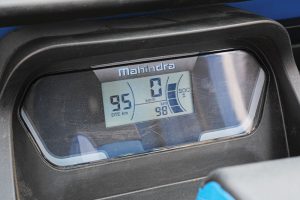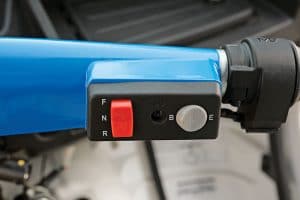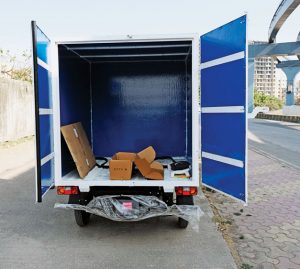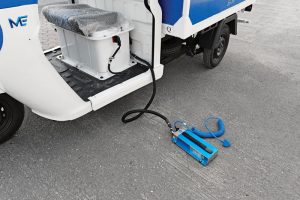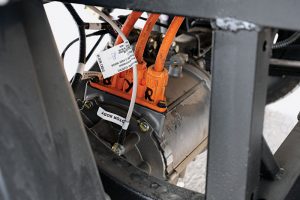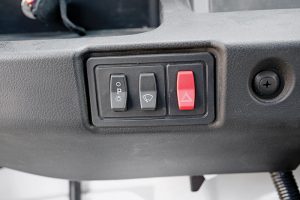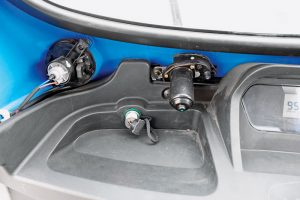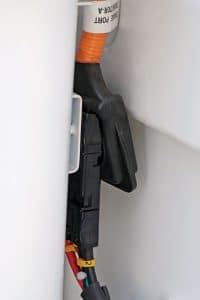
Mahindra Treo Zor has the capability to pull a variety of buyers due to its unique status and build.
Story by Bhushan Mhapralkar
Pictures fail to do justice to the Mahindra Treo Zor electric cargo three-wheeler. They simply don’t; not until the vehicle is seen in flesh and admired. Not only does the vehicle look attractive when seen by the naked eye, it looks a design that seems to nicely marry the art of understanding the market needs with technology and aesthetics. A clue of this is had by the positioning of the 47 kWh lithium-ion battery and its associated electronics in a secured compartment under the driver’s seat. Achieving a good mix of form and function, the electric three-wheeler looks attractive. Creating its own identity in the crowd of diesel cargo three-wheelers, the Treo Zor turns heads. With a single wheel at the front and two wheels at the rear, it is a three-wheeler all right. It is different however, and in a subtle and sophisticated way that is fast becoming a hallmark of the new CVs entering the Indian market. Looking simple yet attractive and appealing, the Treo Zor stands out. With its body made up of rugged SMC body panels at front, in a colour combination of blue and white, the vehicle draws strength from its tubular frame. The SMC panels are bolted to it on the inside. Highlighting the use the light weight alternate materials over steel, the vehicle, coming across as cute, honest and practical, leverages technology to offer a significantly lower TCO as compared to a diesel cargo three wheeler. Despite the use of alternate light-weight material, the vehicle does not ever give an impression of being inferior in its built quality when compared to a diesel cargo three-wheeler either. Coming from an organised that the Mahindra & Mahindra is, the Treo Zor exhibits a rare ability to pulls buyers to it.
Promising Rupees-two per km fuel saving as compared to a diesel cargo three-wheeler, the Treo Zor is also low on maintenance. The Mahindra folks put the figure at fourty-paise per km as compared to a diesel cargo three-wheeler. Backed by a three-year standard warranty, the electric three wheeler weighs 999 kg. With a payload of 550 kg, which is claimed to be the best in class, it is aimed at first mile and last mile applications. Accompanied by a 48V, 2000W AC charger capable of charging the battery in three hours and fifty minutes, the Treo Zor is powered by an eight-kW motor placed adjacent to the rear axle. Calling for a 15A three-pin 230V AC socket that is usually used to drive a home refrigerator or a washing machine at home, the vehicle has the rear half of its frame made of square tubes of various dimensions welded together. The motor controller is placed above the motor and is accessed by removing a square lid built into the cargo tray floor. Unlike the front arrangement where a rather conventional looking fork has the wheel attached to it with the help of a helical spring and shock absorber, the rear suspension is made up of leaf springs and shock absorbers. In the delivery van guise, the superstructure – a box with lockable gates, looks light and usable. Its fit and finish is clearly not in the same league as the rest of the vehicle though.
Available in the pickup guise with a cargo tray that has three-drop sides, the Treo Zor highlights good application flexibility. The flat-bed version could be adapted to serve a number of unique applications and operator/end user needs. Aimed at FMCG, e-commerce, vegetables, fruits, poultry, milk, industrial, electronics and other applications, the electric three- wheeler has a top speed of 50 kmph. Developing a maximum torque of 42 Nm, it has a range of 80 km on a full charge. Having seven-degree grade-ability, the Treo Zor, with a wheelbase of 2216 mm, makes an interesting vehicle indeed. It is positioned in a market that is said to be 110,000 units (per year) strong. Termed as wide-bodied, it measures 3100 mm in length, 1460 mm in width and 1762 mm in height. Competing with the likes of Kinetic Shakti, Gayam Taskman and Singha (Max) as the other cargo electric three wheelers, the Treo Zor looks better conceived and executed. With good fit and finish and build quality to boast of, the vehicle is made at a modern manufacturing facility on the outskirts of Bangalore. Sans a clutch or transmission, it is of the direct drive variety.
A zero tailpipe emission CV, the Treo Zor comes across as innovative in terms of how it drives and feels. It has two drive modes, which influence its drive range. These could be used as per the road and load conditions. The drive mode switch is part of a small switch bank besides the throttle on the handlebar. A red other vertical switch is used to go forward, turn neutral or to reverse. Apart from the accelerator, there’s not much to operate. Like a gearless scooter, the mere twist of the accelerator has the electric three wheeler moving ahead with zest. It feels energetic and agile. Confidence to drive the Treo Zor comes from the fact that it has a robust hydraulic braking system. Press the brake pedal and the vehicles quickly comes to a halt. The ergonomically well designed cabin and a comfortable seating position add to the ease of driving the vehicle. A bigger back cushion squab could offer some more support, and is perhaps one of the few ergonomic shortcomings. The other could be the ORVM placement. To see beyond the delivery box, it is required to tilt the head to either see the left or the right mirror. The ORVMs also seem to jut out far enough to hit another object in a narrow, crowded lane. The delivery box too gives an impression of being a bit too wide. Factoring the same aids driving the electric three-wheeler without side swiping.
Lack of any sound (except some whine of the motor) also calls for careful manoeuvring on a crowded lane. With a ground clearance of 123 mm, the Treo Zor feels stable and reassuring to drive. As part of the well designed and configured dashboard (with lockable glovebox and a 12V charging socket) is a digital instrument cluster that informs of the battery charge in per centage, the range available and more. Riding on 12-inch dia. wheels, the Treo Zor, sold across 20 states, 157 cities and 174 dealerships in India, has high local content. Only a few child parts and cells are imported. With the pickup version priced at Rs.309,000, the flat bed version priced at Rs.303,000, and the delivery van version priced at Rs.338,000, the vehicle is said to be eligible for Rs.74,000 subsidy under the FAME II guidelines, which is Rs.10,000 per kWh. Already serving some big e-commerce players like Amazon, the Treo Zor, amid a growing competition that includes start-ups, legacy players, and organised as well as unorganised players, appeals. Supported by smart features like cloud-connectivity, advanced telematics, reverse parking sensors, and data and machine learning, the vehicle looks promising from a TCO, uptime and TAT point of view. As a first and last mile application, it looks at home in an urban sprawl or a rural expanse. An application-based offering, the Treo Zor displays a rare capability to shake up the traditional order in the cargo three wheeler space. Going by that scale, it looks like a product that could well set a benchmark.




